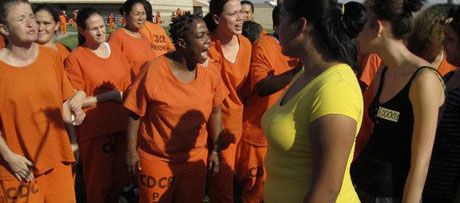“Scared Straight”, the popular 1978 documentary by Arnold Shapiro, has been brought to television as “Beyond Scared Straight.” I avoided watching the new reality television series because all the research shows the scare tactics of taking kids to jail for a day does not work. I was hoping that after one season the show would die and just go away. Unfortunately, it is back for a new season.
How does “Beyond Scared Straight” work? It is easy. You handcuff a few kids, take them on a tour of a jail, and let guards and prisoners scream at them all day until they break. After, the kids go home and never commit a crime again.
Of course, this is the desired end result. In reality, the television series does a follow-up with kids after 30 days and finds that some of the youth report that they have changed, while others say nothing has changed. The show I watched followed up with four kids after 30 days; two said their behavior had improved and two said nothing had changed. Not a very good success rate for 30 days later. I would guess that another follow-up after 90 days might show even worse results.
After Scared Straight became popular in the 1970s, a number of research reports evaluated children who went through the program compared to control groups and found that many of the youth who attended “scared straight” programs were actually worse off than the youth who had no intervention.
The kids that are successful with the scared straight program are the minor offenders, those who are labeled “at risk”, who would have improved without any intervention. We know more about teenage behavior and brain development since the 70s. We now know that most teenagers who commit minor crimes grow out of the behavior. The young brain does not fully develop until the mid 20s and impulse control is weak, at best, in the teen years.
I hope the juvenile advocates keep up the debate on the “Beyond Scared Straight” series. I hate to see limited resources for proven effective youth services be siphoned off for another round of bad practices. Politicians love to cite these scared straight programs, but they are about as effective as the marriages from the Bachelor series.
Sparky Harlan, Executive Director/CEO at Bill Wilson Center, is a nationally recognized advocate for youth in foster care and in the juvenile justice system, as well as homeless and runaway youth. Under her leadership, Bill Wilson Center works to prevent poverty by connecting youth to employment, education, housing, and healthy relationships.





30 days after a stint at Sparky’s also equates to little change. It takes a lot of time and resources to change an entire upbringing… kudos to Harlan for trying. The reality is that once these youngsters have entered the “system” you can mostly write them off.
Poor parenting, schools geared to ESL and politicians who refuse to hold youth accountable are the problem. Can’t blame the Sparkster for advocating for his money-makers, but the real world shows that youth offenders continue to re-offend, up until the point they are adult offenders.
Heck I am scared just looking at the women in orange.
most kids my age arent going to change ,they believe what they are doing is right. what they dont understand is it only takes one big mistake before your life changes for the bad. smoking weed fighting and all that other stuff can lead to jail, dead, or even out on the streets. it really takes more then being yelled at by a couple people to help somone change, its go take for them to really be locked behind thoes bars to actually look at the wrong they are doing to the world. i understand this and im only 14.